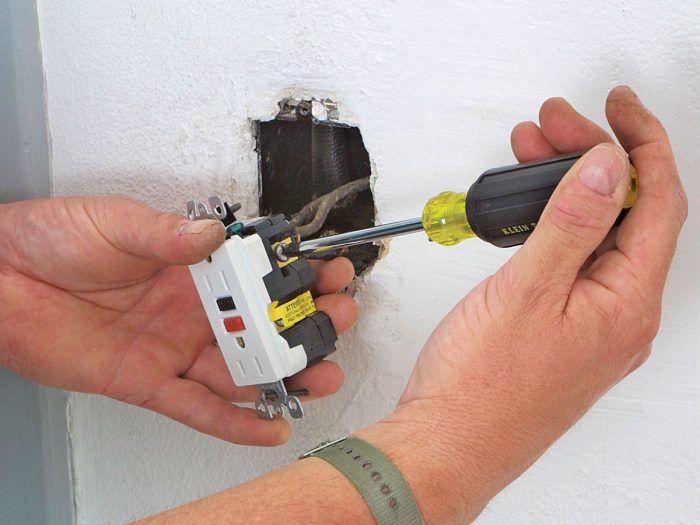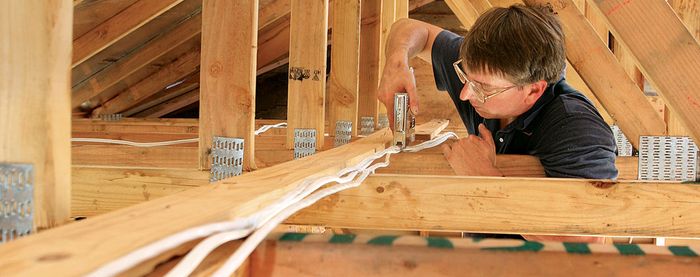Should I Upgrade Ungrounded Wiring?
Modern circuits are grounded for safety, but here's how to deal with ungrounded wiring, which is common in older homes.

Q:
My house was built in about 1946. The electrical service was upgraded to 200 amps, but many of the outlets are still the two-pin style. The wiring appears to be an older cloth-wrapped cable. I’m worried about the grounding of this wiring. Short of replacing all the wire, is there another way to upgrade this system so that I can be sure it is grounded safely? A few ground wires are connected to the cold-water supply, but I believe that they are for a 240v electrical-baseboard heater system.
Steve Shroder, via e-mail, None
A:
Clifford A. Popejoy, a licensed electrical contractor in Sacramento, California, replies: Modern circuits are grounded for safety, so your concern is well-founded. The “ground wire,” more correctly called the equipment ground, is there so that if any metal part of an appliance, tool, lamp, or the like becomes energized, the circuit breaker will trip and keep you from being electrocuted or shocked should you touch the metal part. How might the metal case of a drill become energized? The insulation on a wire inside the drill could become damaged. If that live wire touched the metal case, the tool could be energized to 120v, and that’s not good. If this happens with a grounded tool, a short circuit is created, and the breaker trips.
These days, not many tools, lamps, or appliances have three-pin plugs. That’s because tools and appliances are made with virtually no chance of an exposed metal part becoming energized. They are called “double-insulated.” There’s another insulating barrier between any wire inside the tool and the metal case or other exposed metal part.
How do you get a grounding receptacle outlet in an old system? The code allows a grounding conductor to be run along the existing wiring to the grounding bar on the panel where the circuit originates. Years ago, you could grab a ground from any metal water pipe, but when PVC pipe became common, that option disappeared because there was a real chance that the metal water pipe could be repaired with PVC, interrupting the grounding path.
There’s another approach to dealing with electricity being where it shouldn’t be, like on the metal base of a lamp. Rather than running a separate grounding conductor all the way back to the panel, you could use a ground-fault circuit interrupter, or GFCI (also referred to as a GFI). These safety devices work by detecting any imbalance in electricity flowing out via the hot wire and back via the neutral. If there’s more than a minuscule discrepancy, the GFI cuts power to the receptacle or the circuit. The idea is that if there’s a difference between what’s going out and what’s coming back in, that difference in current might just be leaking out through a person. The trigger level for a GFI is 6 milliamps for 40 milliseconds. Most people wouldn’t experience shock or electrocution if the current flowing through them is less than 6 milliamps for that short a time.
If you replace a standard circuit breaker with a combination circuit breaker/GFI, you will gain shock protection for every outlet or device on the circuit. A 15-amp circuit breaker/GFI costs around $30. The downside to GFI breakers is that they trip often, so you spend a lot of time going to the basement to reset the breaker. I prefer to replace an ungrounded receptacle with a GFI receptacle to get shock protection at that receptacle and at all the other receptacles that are downstream, or farther away from the service panel. The downside is that it’s hard to tell exactly what downstream is in a 60-year-old house. A 15-amp GFI duplex receptacle costs around $15.
I wouldn’t worry about grounding the branch circuit for grounding’s sake. I’m not saying that you shouldn’t ground every outlet, just that the cost is high and the benefit low. Some electrical appliances (such as a surge protector for a computer) should be on a circuit with an equipment ground, but most appliances are doubleinsulated. A lot of safety already is built in.
Rewiring is the best approach, but it is much more expensive than the options I outlined above and is not essential to achieve a good degree of safety.






View Comments
Very informative post relating to electrical wiring. Thank you for sharing this!